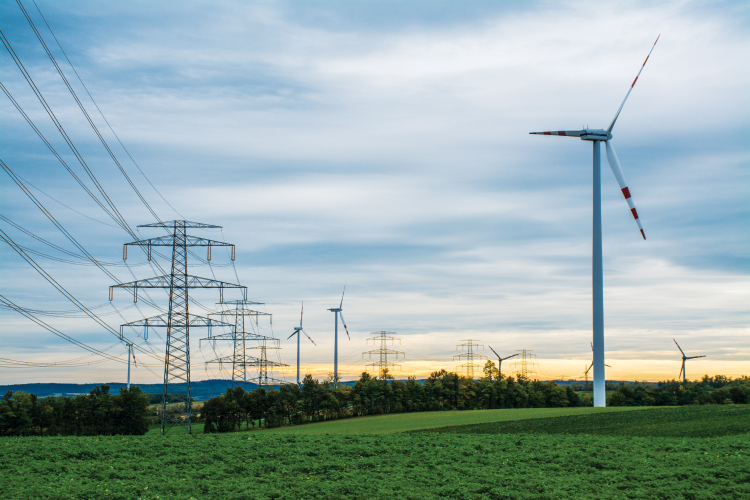Many states in the U.S. have developed aggressive greenhouse gas (GHG) reduction goals as part of their efforts to combat climate change. Such goals typically involve commitments to reduce carbon emissions dramatically by 2050. Many power utilities have followed suit, implementing their own carbon emission reduction goals to conform with state mandates.
To achieve these goals, there needs to be a shift away from fossil fuels, toward more carbon-free energy generation, such as solar, wind and hydro. This needs to be coupled with the electrification of major sectors of the economy, most notably transportation – cars, trucks and other vehicles account for a significant portion of fossil-fuel consumption and associated carbon emissions.
As a result, demand for electricity is expected to increase dramatically over this same period. The National Renewable Energy Laboratory (NREL) has forecasted that the transition to EVs alone will lead to a 20 to 38 percent increase in electricity consumption by 2050.
The net impact of these changes is an increased load on the power grids, coupled with a simultaneous switch of 60 percent of our energy generation away from fossil fuels. As an industry, the power sector has made significant progress in the development of carbon-free energy resources. According to the U.S. Energy Information Administration, carbon-free generation such as nuclear, hydro, wind and solar currently deliver approximately 40 percent of generation in the United States. Equally as important, renewables, such as wind and solar, have become increasingly cost-competitive, comparing favorably with coal, natural gas and other fossil-fuel-based generation.
The point being, we have the technological know-how to replace the fossil-fuel generation sources that need to be retired over the next 30 years. However, today’s transmission system cannot get the renewable energy from where it is generated to where it is needed reliably and economically.

Location matters
There is a mismatch between the ideal locations for renewable energy generation (typically rural, sparsely populated areas), and the locations that have traditionally been served by the transmission grid (specifically coal, gas and nuclear plants in more populated areas).
The U.S. Energy Information Administration predicts that a vast majority of carbon-free energy generation will come from wind and solar. When it comes to wind power, nearly all of it is expected to come from large, utility-scale operations; however, most of the best wind sites are either offshore or in areas that have historically had few energy generation facilities, and typically lack transmission infrastructure.
This is particularly true when it comes to the development of offshore wind. Many states in the northeast already have plans to purchase the output of offshore wind projects. A study by a premier analytical resource for energy information has documented 27.5 GW of offshore wind projects planned along the Atlantic coast for completion by 2035. These projects alone will require a significant investment in the region’s transmission systems, including new overhead or underground transmission lines, substations, undersea cables and monitoring equipment.
While we can expect to see continued development of smaller-scale, “rooftop” solar, most estimates still predict that two-thirds of future solar generation will be at utility-scale. It is easier to find suitable sites for large-scale solar installations than for wind projects, but the most favorable locations for solar development are still in remote, mostly rural areas that are not well served by transmission infrastructure.
This geographical misalignment is already quite evident. A study by the American Council on Renewable Resources (ACORE) found the 15 states between the Rocky Mountains and the Mississippi River account for 88 percent of the U.S.’ wind potential and 56 percent of the country’s utility-scale solar potential. However, in 2020, these states were home to only 30 percent of electricity demand. Moving energy generated in these areas is challenging for two primary reasons - local transmission network constraints, and the lack of a nationwide grid in the U.S. with capacity to move large amounts of power between regions.
Regional grids
The North American grid is in fact four separate, regional grids: The Western Interconnection, the Eastern Interconnection, TransÉnergie in Quebec and the Electric Reliability Council of Texas (ERCOT). These large grids lack the ability to efficiently transfer large amounts of energy between or across grids from areas with favorable conditions for renewable energy to major load centers.
A further complication is that wind and solar energy are produced at variable rates and times. These resources can be curtailed if there is surplus generation, but wind and solar are not considered dispatchable, since they are not available on demand. This limitation creates timing issues when balancing load and generation resources; the grid is not optimized to move power between regions or from one part of a region to another to help address timing issues.
The impacts of timing and location also lead to saturation effects, in which more wind or solar power is generated than is needed at a given time and goes to waste. Energy storage facilities and load shifting programs help with timing issues, but both are currently limited in terms of capacity and availability.
Also, increased use of wind and solar power reduces grid inertia, which is where energy stored in large rotating generators typically found in hydro, fossil fuel or nuclear power plants, but not present in wind and solar arrays. Reductions in grid inertia lead to faster decay in frequency when there is a loss of generation or a major transmission line.
Fortunately, there are still untapped opportunities to use hydro facilities to boost storage capacity. By expanding bi-directional transmission capacity between areas with major hydroelectric facilities and areas with large volumes of renewable generation capacity, excess wind and solar power can be exported to loads that would otherwise be served from hydroelectric facilities. Hydroelectric facilities can in turn reduce output and store energy behind dams, which can later be used to supply loads in the other direction when wind and solar conditions are less favorable.
Existing dams in Quebec, Newfoundland-Labrador, Manitoba and British Columbia provide some of the most efficient and largest installed storage resources in North America, capable of serving as a kind of massive, virtual battery for much of the region. This dynamic is already being played out in Europe, in the case of NordLink, for instance, where existing hydroelectric resources in Scandinavia are being linked to regions to the south that have ambitious wind and solar development plans such as Germany, the Netherlands and the United Kingdom.
Transmission planning
There currently is no overarching energy transmission plan for the United States, let alone North America. Today, each county, state, province and energy region have different infrastructure, capabilities, and prospects for carbon-free generation. Documenting and analyzing this information on a macro level would enable planners to develop a transmission system designed to address future requirements. For instance, comparing where existing transmission resources exist against the locations where large-scale renewables can and will be produced can drive more effective development decisions. Failing to develop such a plan could instead result in a patchwork that recreates many of the transmission problems that we face today, such as intraregional bottlenecks.
There are efforts underway to address this planning gap, such as ACORE’s Macro Grid Initiative, which aims to “connect centers of high renewable resources with centers of high electric demand, enhance grid resiliency and dramatically reduce carbon emissions.” While ACORE suggests that a nationwide high-voltage direct current (HVDC) network is integral to improving the energy transmission system in the United States, there are other approaches that could be beneficial in the short term. For instance, an HVDC system that bridges the three ‘seams’ between energy regions in the U.S. could eliminate many of the choke points in the system.
Technology options
HVDC technology has emerged as a natural fit to address the need to move energy between regions. With an HVDC system, the power flow can be controlled rapidly and accurately with respect to both the power level and direction. This will also improve the performance and efficiency of the connected local AC networks and address the lack of synchronization between regional grids. As a bonus, such HVDC links can also help reduce the risk of uncontrolled propagation of faults in the case of a major disruption.
Another way of addressing many of the transmission capacity issues is to upgrade regional AC transmission systems with Flexible Alternating Current Transmission Systems (FACTS). FACTS are power-electronic based devices that can be integrated into existing AC systems. They increase the power transfer capability, stability, and control of the AC system with series and shunt compensation. FACTS devices such as Static Compensators (STATCOMs) and Series Capacitors are designed to help the grid maximize throughput while remaining stable through varying power flow conditions.
Making connections
Significant efforts have already been made to link renewable-rich areas with major load centers. Some wind-rich states have successfully initiated and developed projects linking solar and wind resources to their regional transmission networks. For instance, the Public Utility Commission of Texas (PUCT) created Competitive Renewable Energy Zones (CREZ) in 2008 to link the wind energy-rich West Texas with the high energy demand of East Texas. The project was completed in 2013 and has enabled the development of 27.7 GW of carbon-free wind generation capacity.
In the Midwest, Midcontinent Independent System Operator’s (MISO) developed the multi-value projects (MVP) program. The program includes 17 projects spanning 9 Midwestern states. The completed projects have already connected 28 GW of wind power to the grid.
Offshore wind
One largely untapped resource in the U.S. where we expect to see increased development is offshore wind. Offshore wind resources on the East Coast represent a tremendous opportunity, but also present unique locational challenges and require dedicated transmission investments.
One of the main challenges with offshore wind is connecting wind generation to the onshore grid and ensuring adequate transmission capacity onshore. There are two options when connecting offshore wind resources to an onshore grid: ‘Gen-Ties’ and offshore transmission grids. A Gen-Tie is a transmission link that directly connects the wind farm to the onshore grid. Offshore transmission grids, in contrast, offer a transmission network that can connect multiple wind farms to the mainland, allowing wind generation developers to focus on collector systems and links from their wind farm to the offshore transmission grid.
Offshore wind interconnection systems can utilize both AC and HVDC transmission lines from offshore wind sites to onshore terminals and substations, which in turn transfer
the energy to the regional grid. For each offshore wind project, onshore grid capacity needs to be studied to determine if additional transmission investment is needed to avoid congestion when the offshore wind is interconnected.
Benefits and challenges
The development of large-scale, carbon-free energy generation comes with a cost. A study by the Brattle Group estimates that to meet state-level carbon-free generation goals, the U.S. will need to invest $12 to $16 billion annually in transmission until 2030. While this is a substantial public infrastructure investment, it would represent a great addition to any economic recovery package and could help offset negative impacts from the COVID-19 pandemic and the associated economic downturn. Not only does it offer direct economic stimulus; it can also lead to the creation of new jobs and generate long-term monetary savings.
When it comes to direct economic stimulus and job creation, transmission projects typically take upwards of 10 years to complete and supply high-quality, consistent employment. The massive scale of projects that need to be undertaken will lead to job creation in nearly every part of the country.
Despite the benefits new transmission projects can offer in terms of facilitating the shift toward renewable energy, not all challenges related to electrical transmission can be solved with technology. In many cases, political dynamics and regulatory requirements play at least as important a role in determining the success or failure of a given project.
This dynamic is particularly evident in the United States. Because renewable generation occurs far from load centers in many instances, transmission systems frequently cross state (and occasionally national) borders, passing through multiple jurisdictions in the process. As a result, the power to regulate these projects often lies with state governments, and local communities can have significant influence on decision-making at this level.
Opposition from local communities concerned about potential environmental and/or health effects associated with transmission, coupled with aesthetic objections, have created roadblocks that have slowed or prevented the completion of some large projects, raising the prospect of substantial financial risk for developers. Often this opposition is compounded by the lack of obvious benefit to local communities from projects that are simply passing through their area, without delivering obvious, immediate benefits.
The development of a unified, national planning process could help eliminate some of this uncertainty. A national plan could help guide siting decisions and give some much-needed clarity and confidence to developers, both of transmission infrastructure and renewable generation projects, as to the required steps and likely outcomes of development projects.
The path to a carbon-neutral future
To reduce the nation’s carbon footprint and meet GHG emission goals, we need to implement large-scale carbon-free generation resources and electrify major sectors of our economy, most notably transportation. Currently, the largest hurdle for this development is modernizing the transmission grid to accommodate renewable energy generation and electrification of the economy. Investing in transmission system technology that expands the capacity to transfer energy from areas with favorable conditions for renewable energy development to major load centers and that bridges regional seams is crucial to meeting these goals. Despite these challenges and large financial investments, de-carbonizing society will create long-term economic, social, and health benefits for the country. When combined, strategic transmission investment coupled with renewable energy development can be a powerful contributor to economic growth, job creation, prosperity and ultimately the achievement of a carbon-neutral future.
 Anthony Allard is executive vice president, managing director, United States and head of Hitachi ABB Power Grids’ business in North America. Allard was most recently chief operating officer of BECIS, a leading energy as a service solution provider in Singapore. Having spent most of his career in the power sector at GE and Alstom in the U.S., he held several executive-level positions, including general manager and board member for GE Prolec Transformers in the U.S. He was also general m for the GE-XD High Voltage Products partnership and spent 10 years working for Alstom Grid in both North America and the Americas in strategy and operations management role.
Anthony Allard is executive vice president, managing director, United States and head of Hitachi ABB Power Grids’ business in North America. Allard was most recently chief operating officer of BECIS, a leading energy as a service solution provider in Singapore. Having spent most of his career in the power sector at GE and Alstom in the U.S., he held several executive-level positions, including general manager and board member for GE Prolec Transformers in the U.S. He was also general m for the GE-XD High Voltage Products partnership and spent 10 years working for Alstom Grid in both North America and the Americas in strategy and operations management role.








